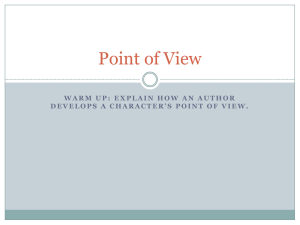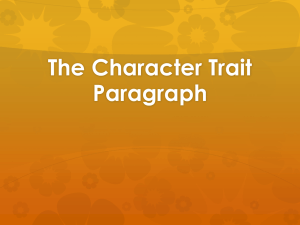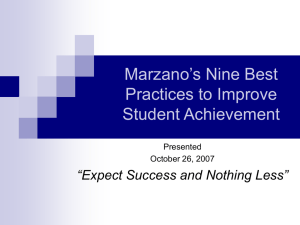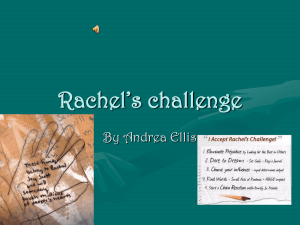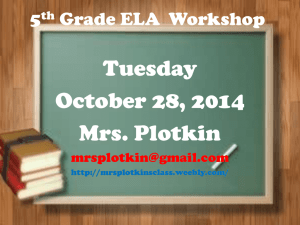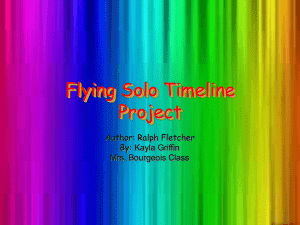Eleven - Achieve the Core
advertisement
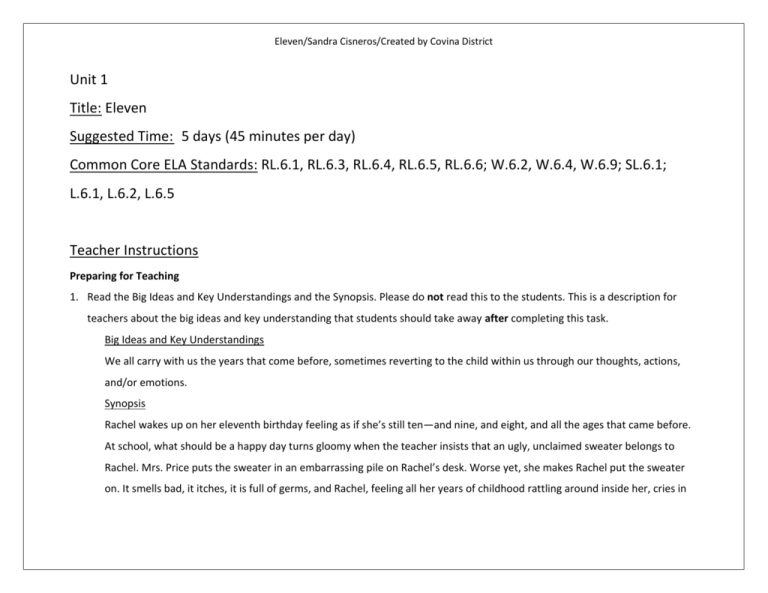
Eleven/Sandra Cisneros/Created by Covina District Unit 1 Title: Eleven Suggested Time: 5 days (45 minutes per day) Common Core ELA Standards: RL.6.1, RL.6.3, RL.6.4, RL.6.5, RL.6.6; W.6.2, W.6.4, W.6.9; SL.6.1; L.6.1, L.6.2, L.6.5 Teacher Instructions Preparing for Teaching 1. Read the Big Ideas and Key Understandings and the Synopsis. Please do not read this to the students. This is a description for teachers about the big ideas and key understanding that students should take away after completing this task. Big Ideas and Key Understandings We all carry with us the years that come before, sometimes reverting to the child within us through our thoughts, actions, and/or emotions. Synopsis Rachel wakes up on her eleventh birthday feeling as if she’s still ten—and nine, and eight, and all the ages that came before. At school, what should be a happy day turns gloomy when the teacher insists that an ugly, unclaimed sweater belongs to Rachel. Mrs. Price puts the sweater in an embarrassing pile on Rachel’s desk. Worse yet, she makes Rachel put the sweater on. It smells bad, it itches, it is full of germs, and Rachel, feeling all her years of childhood rattling around inside her, cries in Eleven/Sandra Cisneros/Created by Covina District front of the whole class. The classmate who is the real owner of the sweater finally claims it, while Rachel longs for the day to end. 2. Read the entire selection, keeping in mind the Big Ideas and Key Understandings. 3. Re-read the text while noting the stopping points for the Text Dependent Questions and teaching Tier II/academic vocabulary. During Teaching 1. Teacher reads the text aloud while students follow along. 2. Students and teacher re-read the text while stopping to respond to and discuss the questions, continually returning to the text. A variety of methods can be used to structure the reading and discussion (i.e., whole class discussion, think-pair-share, independent written response, group work, etc.) Text Dependent Questions Text-dependent Questions In paragraph three, the author includes figurative language. How does the figurative language in the text help the reader understand the character’s feelings about getting older? (Pg. 27) Evidence-based Answers Cisneros writes “the way you grow old is kind of like an onion or like the rings inside a tree trunk or like my little wooden dolls that fit one inside the other, each year inside the next one”. All three have layers numbered like years and are part of the whole identity. This is especially true of the tree with the rings representing how an outside source can affect the growth and development of each individual ring/year and how the rings underneath affect and build upon the outer layers and years. On page 27 the author stated, “Only today I wish I didn’t have The pennies represent the emotions that are rattling inside of only eleven years rattling inside me like pennies in a tin can.” Rachel. They can represent more than one maturity or age level What does this figurative language mean and how does it affect in a moment. This reflects her anxious tone. Her emotions are the tone of the text? (Pg. 27) bouncing within her as loudly as pennies in a tin can. Reread the first four paragraphs and note how many times the The author begins a sentence with the word “and” 5 times. This Eleven/Sandra Cisneros/Created by Covina District author starts a sentence with the word “and”. Why does the author make this choice? (Pg. 27) When Sylvia says the sweater belongs to Rachel, how does Rachel respond? What does this reveal about how Rachel feels about herself? (Pg. 28) Why does Rachel feel that Mrs. Price is “right”? Give evidence from the text to support your answer. (Pg. 28) In paragraph twelve beginning “Not mine, not mine, not mine”, what does the text and how Rachel responds to the situation tell us about Rachel’s character? (Pg. 28) How does Rachel feel about the sweater? Include evidence from the text to support your answer. (Pg. 28) Identify each time Rachel claims “not mine”. Why does the author repeat this refrain throughout the story and how does it affect the overall meaning and tone of the text? (Pg. 28) reflects Rachel’s anxiety as she rambles her thoughts about her birthday. It also reflects speaking voice rather than a writing voice. This definitely sounds like Rachel as an eleven-year old narrator thinking aloud. Rachel responds with negative self-talk, “I’m skinny, maybe because she doesn’t like me…” She feels angry when she calls Sylvia stupid. She also feels insulted because Mrs. Price believes her. She reverts to “me when I was four”, when she partially responds in a little voice. Rachel feels that Mrs. Price is older and wiser. The common perception is that older equals wiser. She states, “Because she’s older and the teacher, she’s right and I’m not.” It also demonstrates authority trumping childhood, even when the child is right. Rachel shows maturity by controlling her emotions. Rather than reverting to a crying three year-old, she emotionally removes herself from the uncomfortable moment by remembering the birthday celebration that awaits her when she gets home. Rachel hates the sweater so much that it upsets her. Rachel calls it an ugly sweater, all raggedy and old. She is upset over Sylvia’s claim that it belongs to Rachel, not claiming the sweater as hers. She calls it a big red mountain and she moves it to the corner of her desk with a ruler. She devises all these plans on how to get rid of the sweater (i.e. throw over schoolyard fence, hang on parking meter, toss in alley). Even though Rachel is eleven, she speaks with the whiney tone of a three-year old. Her thoughts of the sweater consume her entire being. A more mature person can compartmentalize. The refrain “not mine, not mine, not mine” demonstrates Rachel’s determination that she is right and Mrs. Price is wrong. This connects to the Big Idea because Rachel is reverting to her Eleven/Sandra Cisneros/Created by Covina District inner 3-year old. In paragraph nineteen, count the words that begin with the sentence “My face all hot…” Identify other sentences from paragraphs fourteen through nineteen that are of similar lengths. Why does the author choose to write such lengthy sentences in paragraphs fourteen through nineteen? (Pg. 29) When the text states, “Mrs. Price pretends like everything’s okay”, what age does this reflect? Why? (Pg. 29) In paragraph five and in the last paragraph, Rachel says she wants to be 102. In each instance, why does Rachel want to be 102? (Pg.29) How has Rachel grown older today? Include evidence from the text to support your answer. (Pg. 29) There are 58 words. For further examples of long run-on sentences, please check paragraphs fourteen, eighteen, and nineteen. The author’s change in sentence structure reflects a change in Rachel’s internal dialogue. The run-on-, a list of Rachel’s body reactions (face all hot, spit coming out of mouth, animal noises, no more tears, shaking body) reflects Rachel’s intensity of emotions, culminating with her crying in class. Someone who is mature would admit they were wrong and apologize, without ignoring the problem. Mrs. Price does not do this, which shows less maturity and that even people of older ages do not always act in a mature manner. Responses will vary. In paragraph five, Rachel would have had the wisdom to handle the situation with Mrs. Price. She says “if I was one hundred and two I’d have known what to say when Mrs. Price put the red sweater on my desk”. In the last paragraph, Rachel wants the red sweater incident to be far in the past, “far away like a runaway balloon, like a tiny o in the sky, so tiny-tiny you have to close your eyes to see it”. Rachel has accepted the fact that she is eleven and life will require people to bear difficulties. She has learned that we all carry with us the years that come before, sometimes reverting to the child within us. This is demonstrated in the last paragraph when Rachel says “I’m eleven today. I’m eleven, ten, nine, eight, seven, six, five, four, three, two, and one, but I wish I was one hundred and two”. Eleven/Sandra Cisneros/Created by Covina District Meaning needs to be provided Meaning can be learned from context Tier II/Academic Vocabulary These words require less time to learn These words require more time to learn (They are concrete or describe an object/event/ process/characteristic that is familiar to students) (They are abstract, have multiple meanings, are a part of a word family, or are likely to appear again in future texts) Page 27 – rattling Page 28 – raggedy Page 29 – alley Page 29 – clown-sweater Page 28 – coatroom Page 28 – parking meter Page 29 – runaway balloon Page 27 – rings Page 28 – nonsense Page 29 – bury Eleven/Sandra Cisneros/Created by Covina District Culminating Writing Task Prompt In the short story, “Eleven”, by Sandra Cisneros, in what ways do Rachel’s reactions demonstrate her multiple “years” of her eleven year-old self? Write a one-page essay summarizing the ways that Rachel responds. Include textual evidence to support your interpretation of the age that her actions demonstrate. Teacher Instructions 1. Students identify their writing task from the prompt provided. 2. Working in groups, students create a continuum line of age maturity based on Rachel’s reactions about the red sweater. Students will place the textual events below the line and the justification of placement above the line. (Example below) Rachel is acting as though she is 3 years old, having a toddlerlike tantrum over being upset about the red sweater. By wanting to throw the sweater into the alley, Rachel is trying to avoid an unpleasant situation, which can be viewed as being “childish”. __________ * _______________ This statement shows that Rachel is resigned to the fact that her birthday has been ruined and that she will have to accept reality of her bad experience. *_______________________________________* __________________* ________________ Birth “…spit coming out of my mouth because I can’t stop the little animal noises from coming out of me” (Page 29) Rachel is trying to remove herself from the negative situation by thinking of positive thoughts and selfsoothing. This demonstrates an adult-like behavior. Adult “…bunch it up into a little ball and toss it in the alley” (Page 28) “There’ll be candles and presents, and everybody will sing Happy birthday, happy birthday to you, Rachel, only it’s too late.” (Page 29) “…Mama is making a cake for me tonight, and when Papa comes home everybody will sing Happy birthday, happy birthday to you.” (Page 28) Eleven/Sandra Cisneros/Created by Covina District 3. After students have completed their group continuum lines, post them around the room and have a “gallery walk”. 4. The teacher will choose one to three common events from the story in which groups show differences of placement on the line. 5. As a whole class discussion, groups will defend their choice of placement on the line. 6. Students complete an evidence chart using their continuum. Teachers should remind students to also use any relevant notes they compiled while reading and answering the text-dependent questions (Example below) Evidence Quote or paraphrase “…spit coming out of my mouth because I can’t stop the little animals noises from coming out of me” Page number 29 Rachel is acting as though she is 3 years old having a toddler-like tantrum over being upset about the red sweater. 28 By wanting to throw the sweater into the alley, Rachel is trying to avoid an unpleasant situation, which can be viewed as being “childish”. 29 This statement shows that Rachel has resigned to the fact that her birthday has been ruined and that she will have to accept reality of her bad experience. 28 Rachel is trying to remove herself from the negative situation by thinking of positive thoughts and selfsoothing. This demonstrates adult-like behavior. “…bunch it up into a little ball and toss it in the alley” “There’ll be candles and presents, and everybody will sing Happy birthday, happy birthday to you, Rachel, only it’s too late.” “…today I am eleven, eleven. Mama is making a cake for me tonight, and when Papa comes home everybody will sing Happy birthday, happy birthday to you.” “when you’re eleven, you’re also ten, and nine, and eight, and seven, and six, and five, and four, and three, and two, and one” Justification of Events’ Placements 27 Rachel reflects wisdom beyond her eleven years when she analyzes her feelings/reactions about the events that occur on her eleventh birthday. She realizes the complexity of ages that people experience within themselves. Eleven/Sandra Cisneros/Created by Covina District 7. Once students have completed the evidence chart, they should look back at the writing prompt in order to remind themselves what kind of response they are writing (i.e. expository, analytical, argumentative) and think about the evidence they found. (Depending on the grade level, teachers may want to review students’ evidence charts in some way to ensure accuracy.) From here, students should develop a specific thesis statement. This could be done independently, with a partner, small group, or the entire class. Consider directing students to the following sites to learn more about thesis statements: http://owl.english.purdue.edu/owl/resource/545/01/ OR http://www.indiana.edu/~wts/pamphlets/ thesis_statement.shtml. 8. Students compose a rough draft. With regard to grade level and student ability, teachers should decide how much scaffolding they will provide during this process (i.e. modeling, showing example pieces, sharing work as students go). 9. Students complete final draft. Sample Answer Birthdays are usually occasions for joy, celebrated with presents and cake and acts of love. Each birthday marks the arrival of a new year in a person’s life. With the arrival of that special day, a person is an entire year older. In Sandra Cisneros’ short story “Eleven”, Rachel’s eleventh birthday is not a happy day, which gives her reason to think about what it means to turn eleven. In the first paragraph of the story, Rachel reflects that “when you’re eleven, you’re also ten, and nine, and eight, and seven, and six, and five, and four, and three, and two, and one” (27). She compares all those years within a person to an onion, the rings inside a tree trunk, and wooden dolls that fit inside each other. Rachel’s variety of reactions to the fact that her teacher wrongly accuses her of being the owner of an ugly, red sweater demonstrate the multiple years existing within her eleven-year-old self. When Mrs. Price first tells Rachel the sweater is hers, Rachel reacts with maturity beyond her years. She fights the younger ages trying to emerge by telling herself, “…today I am eleven, eleven. Mama is making a cake for me tonight, and when Papa comes home everybody will sing Happy birthday, happy birthday to you” (28). She is fighting childish reactions with an adult-like Eleven/Sandra Cisneros/Created by Covina District strategy of emotionally removing herself from a negative situation by focusing on positive thoughts. She can put up with the sweater because something wonderful awaits her at home. With the ugly red sweater still on her desk, Rachel has difficulty continuing the more mature strategy of compartmentalization. She creates her own reality, imagining that she will throw the red sweater “over the schoolyard fence, or leave it hanging on a parking meter, or bunch it up into a little ball and toss it in the alley” (28). She is doing all she can to avoid an unpleasant situation, and avoidance is generally thought to be an immature response to a problem. When Mrs. Price makes Rachel wear the sweater, all attempts at maturity are lost. Rachel thinks, “I’m eleven and it’s my birthday today and I’m crying like I’m three in front of everybody . . . spit coming out of my mouth because I can’t stop the little animal noises from coming out of me” (29). Clearly, she recognizes that even though she is eleven, she’s responding like a three-year old. At the end of the story, Rachel says “I’m eleven today. I’m eleven, ten, nine, eight, seven, six, five, four, three, two, and one” (29). She seems to have resigned herself to the reality of the experience, for she knows that we all carry with us the years that came before, sometimes reverting to the child within us. Additional Tasks Have students complete the “Literary Analysis SkillBuilder: Character” from the Unit One Resource Book (see below). This will allow students to identify and support character traits of Rachel and Mrs. Price, as well as determine the impact of those traits on the resolution of the story. Literary Analysis SkillBuilder Character Eleven/Sandra Cisneros/Created by Covina District Characters are the people, animals, or imaginary creatures that take part in the action of a story. The main character is usually the focus of the action in the story and is most important. There may be one or more minor characters who interact with the main character and help move the story along. You can learn about the personalities of story characters by determining their traits or qualities. Pay attention to the following details to learn a character’s traits: o the character’s thoughts, feelings, and actions o the speech, thoughts, and actions of other characters o the writer’s direct statements about the character o descriptions of the character’s appearance What are Rachel’s traits? What are Mrs. Price’s traits? In the chart below, note the traits shown by each character and the language or behavior that support your observations. Rachel Trait Evidence Trait Evidence Mrs. Price Eleven/Sandra Cisneros/Created by Covina District Trait Evidence If you are utilizing the Unit Once Resource Book, replace the worksheet’s “Follow Up” question with the one below: o Choose one trait from either Rachel or Mrs. Price and explain how that trait affects the resolution of the story. How would the story’s resolution be different if Rachel or Mrs. Price did not exhibit that trait? Answer: Responses will vary. Possible responses are provided. Rachel: o Trait: sensitive Evidence: Rachel acts embarrassed at being singled out; she cries after she is forced to wear the red sweater. o Trait: inarticulate Evidence: Rachel can’t find the words to explain convincingly to Mrs. Price that the sweater is not hers. o Trait: respectful Evidence: Rachel doesn’t feel it is her place to argue with a teacher. Mrs. Price o Trait: insensitive Eleven/Sandra Cisneros/Created by Covina District Evidence: Mrs. Price doesn’t think about why Rachel would tell her the sweater isn’t hers, she doesn’t notice or care that Rachel is upset, and she doesn’t apologize for her mistake. o Trait: authoritative Evidence: Mrs. Price demands that Rachel put on the sweater, not just keep it on her desk. o Trait: persistent Evidence: Mrs. Price refuses to let the sweater issue go. One of Mrs. Price’s traits is being authoritative. If she had not demanded that Rachel put on the sweater, and if she had not insisted that the sweater belonged to Rachel, Rachel would have not been humiliated. She may have enjoyed her birthday. However, Rachel would not have learned that we all carry with us the years that come before. From paragraph nineteen, page 29, rewrite the run-on sentence that begins with “My face all hot…” (Note to Teacher: This activity will highlight Cisneros’ intentional use of run-ons to develop the narrator’s speaking voice, as well as give the students practice at developing proper sentence structure.) Answer: Answers will vary. One example is: My face is all hot and spit comes out of my mouth. I can’t stop the little animal noises from coming out of me, and finally there aren’t any more tears left in my eyes. It’s just my body shaking like when you have the hiccups, and my whole head hurts like when you drink milk too fast. Note to Teacher Questions and answers from the Unit One Resource book have been modified. Please refer to answers above.
